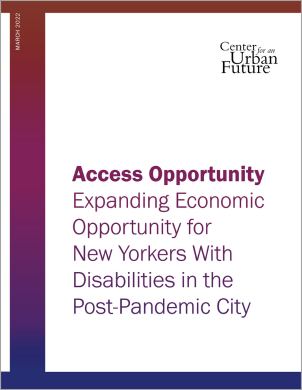10 Ideas for Strengthening New York City as a Leader in Employment for People With Disabilities
Almost one million New Yorkers across a range of disabilities have a unique potential to harness immense economic opportunity in an equitable recovery. With a new mayoral administration, New York City has the chance to become a national leader in inclusivity for people with disabilities in the workplace. This population and its advocates face structural and pandemic-based challenges, such as the benefits cliff, no clear diversity initiatives, a shortage of funding, and a lack of awareness on disability issues.
Enormous shifts in the ways New Yorkers live, work, and train for employment—coupled with accelerating advances in technology—have created the conditions for a new era of employment accessibility. If city leaders meet the challenge of lowering the unemployment rate for working-age New Yorkers with disabilities and boosting labor force participation, the more than $3.4 billion in additional wages generated annually would have ripple effects in every community across the five boroughs.
With adequate funding, high-level leadership, and targeted policy interventions, city and state government can strengthen and restructure the existing system of training structures and foster a more equitable labor market in which people with disabilities can better access quality employment opportunities and outcomes. To make this vision a reality, city and state officials should consider the following recommendations.
- Launch a $10 million accessibility training challenge grant for city workforce development organizations to build accessibility for people with disabilities into their services. Even though 50 percent or more of the clients at many workforce development organizations may have a disability, most of these organizations do not have the specialized knowledge and resources to optimize their services for a range of disabilities. Integrating disability employment services into the wider workforce landscape could move thousands more New Yorkers with disabilities into employment. The city should make a major $10 million investment in 2022 that workforce development organizations can use to start disability-specific initiatives. This funding should include partnerships with direct service providers and NYC: ATWORK to serve as resources. Interviews with almost a dozen of these community-based organizations revealed two main areas for funding: awareness training and dedicated staff. General workforce organizations should strive to embed vocational rehabilitation counselors in their own services so they can screen clients and create plans for inclusivity.
- Scale up the government programs that are working, such as NYC: ATWORK and EmpoweredNYC. Since 2018, the NYC: ATWORK program, which provides employment services to people with disabilities, has connected 500 workers to jobs, earning an annual salary averaging about $51,000.1 These outcomes are all the more impressive because investment has been minimal. A new investment of approximately $2.5 million could supercharge NYC: AT WORK by expanding business development capacity, sparking new career training programs like the IT Academy, and tripling the number of New Yorkers served annually. The 2019 EmpoweredNYC pilot also proved successful, with 667 New Yorkers participating in more than 1,100 financial counseling sessions.2 As of December 2021, the nascent program has helped more than 1,000 participants.3 Scaling up EmpoweredNYC could also expand access to benefits counseling, increasing uptake for current government programs, reducing fear about the benefits cliff for people with disabilities, and supporting better outcomes for New Yorkers pursuing education and job training.
- Establish a 7 percent hiring target for people with disabilities in city jobs and city contracts and measure progress on 55-a hiring across government. By leveraging its purchasing power and requiring a certain percentage of jobs in city government or paid for through city contracts to be held by people with disabilities, government can incentivize a significant expansion of inclusive workplaces and boost the visibility of workers with disabilities. In its recent review of the federal hiring target, the U.S. Department of Labor found that a majority of the contractors who measured the target by job group met or exceeded the goal in at least one category.4 In addition to setting this goal across government, the city should commit to filling all 55-a slots in civil service roles and make this data public for every agency.
- Launch mobile small business accessibility teams to help make 2,500 small- and medium-sized business workplaces accessible to employees with disabilities by 2025. To combat harmful misinformation and market the array of programs and incentives that are available for employers of disabled people, Mayor Adams should direct the Department of Small Business Services to work with MOPD to launch five mobile Small Business Accessibility Teams charged with helping make 2,500 small- and medium-sized business workplaces accessible to employees with disabilities by 2025.These teams would go door to door and hold virtual training sessions across all five boroughs, helping businesses understand the benefits of hiring disabled workers, the supports available to provide accommodations, and the providers that exist to help source talent, and make connections to other business owners who have made accessibility a priority and can share their experiences and the benefits. The mayor can also embed satellite teams into the city’s Workforce1 Centers to help clients with disabilities navigate training and employment options while coaching center staff on disability etiquette, best practices, and reasonable accomodations.
- Create a $1 milllion workplace access fund, seeded with public and private dollars, to support the rapid deployment of accommodations in businesses across New York City. Consulting firm Booz Allen Hamilton has established a centralized fund to cover employee accommodations across the organization—a best practice that other major firms have begun to adopt. For most small businesses—the majority of firms in New York City—these costs are a significant barrier. New York City can address the situation by working with private-sector partners and philanthropy to seed a Workplace Access Fund, which would provide grants to small businesses to implement workplace accommodations. Whether a screen reader, a translator, or a job coach, reasonable accommodations can boost job performance for people with disabilities and open new employment opportunities in small businesses across the city. In addition to starting this fund, New York City can take the lead and launch a similar, internal fund to enable all city agencies to accommodate its hires with disabilities regardless of the agency’s financial needs.
- New York State should reform ACCES-VR to place more people with disabilities in quality jobs—and elmininate the benefits cliff. ACCES-VR is the primary state vehicle for employment services for people with disabilities. But caseloads have become unmanageable and employment outcomes have been subpar.5 The next governor and state legislature should reform ACCES-VR so that it can perform at its fullest potential and place thousands of more New Yorkers into jobs. Rather than incentivizing a rapid-attachment model of employment, the state could mandate different benchmarks based on the intensity of training and education offered and the ability to foster collaboration among provider organizations that meet longer-term employment goals. The state should also direct funding to incentivize innovation through stronger industry partnerships, such as creation of career training pathways in technology, education, creative industries, the care economy, and the emerging green economy. The state could also embed ACCES-VR counselors in high-performing general workforce development organizations and double the number of ACCES-VR counselors to help reduce caseloads and improve response times. In addition to these changes to ACCES-VR, Governor Hochul and the State Legislature should work together on legislation to alleviate the benefits cliff by encouraging increased earnings and allowing more savings while maintaining eligibility for these crucial supports, including initiating a program that covers benefits for working people with disabilities. The governor may look to Massachusetts’ MassHealth CommonHealth program as a model for expanding healthcare coverage for people with disabilities whose income exceeds the cut-off level.6
- Issue flexible workforce development contracts that incorporate accessibility goals and expand city workforce funding to more disability-serving organizations. New York City’s publicly funded workforce development contracts have historically locked out providers that serve people with disabilities due to a lack of focus on accessibility as a criterion, inflexible rules around reimbursement rates, and insufficient funding for needed supports. To address this inequity, the mayor should direct each agency responsible for issuing workforce development contracts to integrate accessibility goals into future contracts and develop new RFPs specifically focused on serving New Yorkers with disabilities. To help facilitate these changes, City Hall should consider hiring a Senior Advisor for Workforce Accessibility on the team of the Deputy Mayor for Economic and Workforce Development, responsible for ensuring that economic and workforce development initiatives includes clear accessibility goals and metrics.
- Launch a campaign to develop internship and apprenticeship opportunities accessible to New Yorkers with disabilities. Misunderstandings among employers about job performance and costs when hiring people with disabilities are deep rooted. An effective strategy to address this situation is to expose employers to people with disabilities in the workplace through internships and apprenticeships. A 2014 study surveying 675 human resource professionals found that internships made it almost six times more likely that a person with a disability would be hired.7 But to date there has been no coordinated citywide effort to promote and expand the number of work-based learning opportunities accessible to New Yorkers with disabilities. The mayor and City Council should work together to create a new Accessible NYC internship campaign, recruiting partners across the private sector and in each government agency. Internships and apprenticeships can give people with disabilities real-world experience they can use for future work opportunities; meanwhile, employers can fully understand the diversity and talent New Yorkers with disabilities have to offer. New York should lead the way by identifying at least 500 companies that offer paid work-based learning opportunities that are accessible to New Yorkers with disabilities and set a goal of connecting 5,000 New Yorkers with disabilities annually with paid work-based learning opportunities.
- Embrace remote work while allocating new resources to close the digital divide. Disability advocates have long called for remote work options for certain people with disabilities, and the pandemic has proved that this modality is possible at a large scale. But our data analysis reveals a 20 percentage point divide in household computer access between New Yorkers with disabilities and those without one.8 Although the city should continue to embrace remote work as an inclusive option for many New Yorkers, for remote work opportunities to be reach all New Yorkers with disabilities, the city first needs to make further progress in closing the digital divide. This should include a significant new investment focused on expanding digital equity for New Yorkers with disabilities, including assistive technology, broadband access, Internet-enabled devices, and digital skills training on how to use devices and digital programs.
- Build a central directory of career services providers for people with disabilities, their employers, and the organizations that serve them. Direct service providers for people with disabilities have the expertise in working with people across a range of disabilities, yet many workforce organizations and small business assistance organizations express the need for better visibility into potential partners with this specific expertise. One of the simplest and most effective ways to raise awareness about these programs is to create a centralized directory of service providers. This directory should be accessible across a range of disabilities and include information on training programs for provider organizations and employers as well as for jobseekers. General workforce organizations could use this directory to gain insight into potential training partners, and employers who seek to build inclusive workplaces can also locate workforce providers who can help them source talent for open jobs.
Endnotes
- EmpoweredNYC, AccessibleNYC: 2021 Edition, The City of New York (New York: Mayor’s Office for People with Disabilities, 2021).
- Ibid.
- NYC Consumer and Worker Protection, “EmpoweredNYC Helps New Yorkers with Disabilities Achieve Nearly Half Million Dollars in Savings and Debt Reduction,” December 2021.
- DOL, Office of Federal Contract Compliance Programs, “Section 503 Focused Reviews: Fiscal Year 202 Annual Report,” January 28, 2021.
- NYSRC, “Seeing the Light.”
- MassHealth, “MassHealth CommonHealth,” 2017.
- William A. Erickson, Sarah von Schrader, Susanne M. Bruyère, Sara A. VanLooy, and Davis S. Matteson, “Disability-Inclusive Employer Practices and Hiring of Individuals With Disabilities,” Rehabilitation Research, Policy, and Education 28, no. 4 (2014): 309–28.
- Center for an Urban Future analysis of data from the 2015- 2019 American Community Survey 5-year-estimates.





